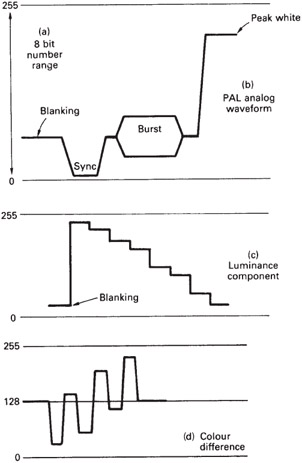2.10 Binary Codes for Video
| | ||
| | ||
| | ||
2.10 Binary Codes for Video
There are a wide variety of waveform types encountered in video, and all of these can be successfully digitized. All that is needed is for the quantizing range to be a little greater than the useful voltage range of the waveform.
Composite video contains an embedded subcarrier, which has meaningful levels above white and below black. The quantizing range has to be extended to embrace the total possible excursion of luminance plus subcarrier. The resultant range is so close to the overall range of the signal that, in composite working, the whole signal, including syncs, is made to fit into the quantizing range as Figure 2.31 (b) shows. This is particularly useful in PAL because the sampling points are locked to subcarrier , and have a complex relationship to sync. Clearly black level no longer corresponds to digital zero. In eight-bit PAL it is 64 10 . It is as if a constant of 64 had been added to every sample, and gives rise to the term offset binary.

Figure 2.31: The unipolar quantizing range of an eight-bit pure binary system is shown at (a). The analog input must be shifted to fit into the quantizing range, as shown for PAL at (b). In component, sync pulses are not digitized, so the quantizing intervals can be smaller as at (c). An offset of half scale is used for colour difference signals (d).
In the luminance component signal, the useful waveform is unipolar and can only vary between black and white, since the syncs carry no information that cannot be recreated. Only the active line is coded and the quantizing range is optimized to suit the gamut of unblanked luminance as shown in Figure 2.31 (c). The same approach is used in HD component signals.
Chroma and colour difference signals are bipolar and can have values above and below blanking. In this they have the same characteristics as audio and require to be processed using two's complement coding as described in the previous section. However, two's complement is not used in standard digital video interfaces as the codes of all ones and all zeros are reserved for synchronizing and in two's complement these would appear in the centre of the quantizing range. Instead digital video interfaces use an offset of half full scale to shift blanking level to the centre of the scale as shown in Figure 2.31 (d). All ones and all zeros are then at the ends of the scale. Such an offset binary signal can easily be converted to two's complement by inverting the MSB as shown in Figure 2.30. If the quantizing range were set to exactly the video signal range or gamut, a slightly excessive gain somewhere in the analog input path would cause clipping. In practice the quantizing range will be a little greater than the nominal signal range and as a result even the unipolar luminance signal has an offset blanking level. A video interface format must specify the numerical values that result from reference analog levels so that all transmissions will result in identical signals at all receiving devices.
| | ||
| | ||
| | ||
EAN: 2147483647
Pages: 120